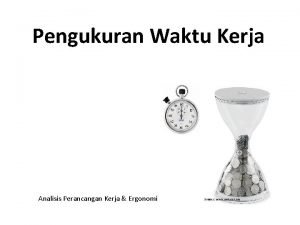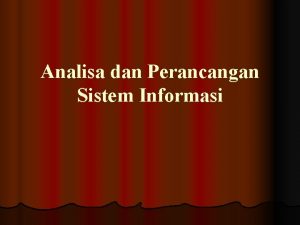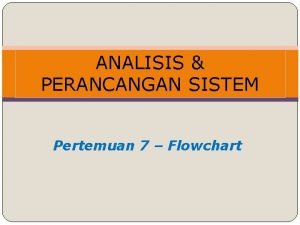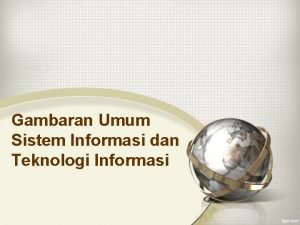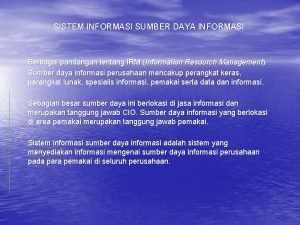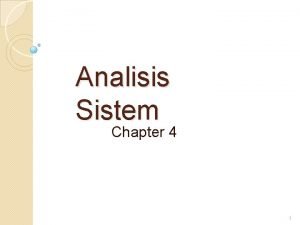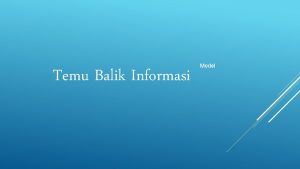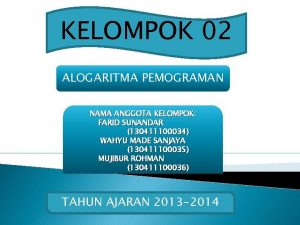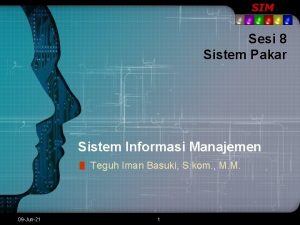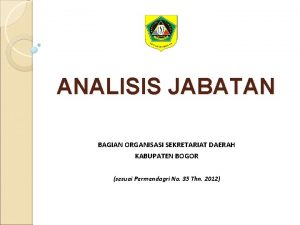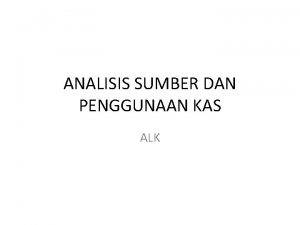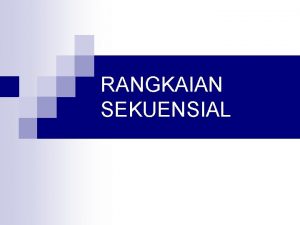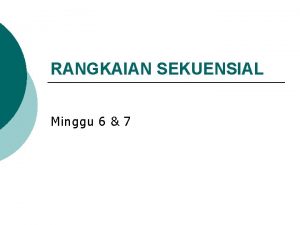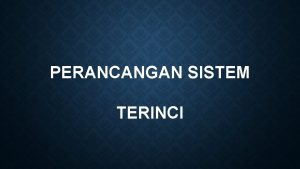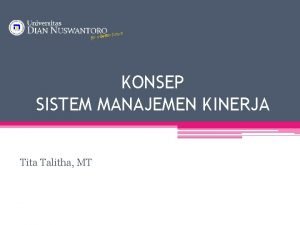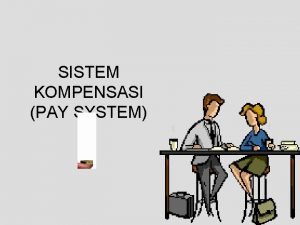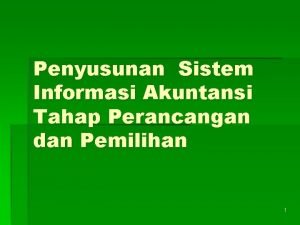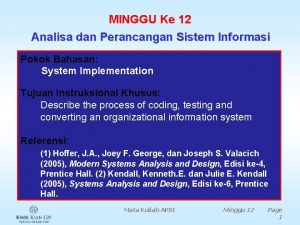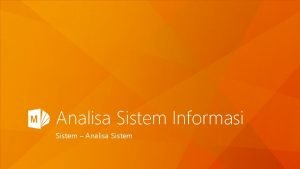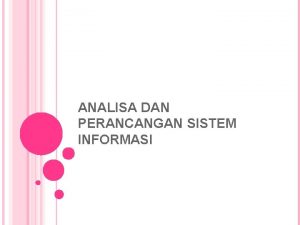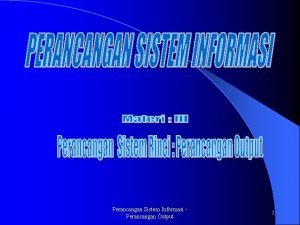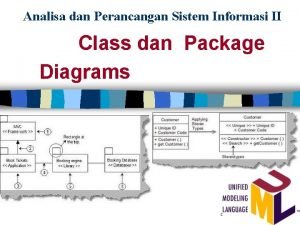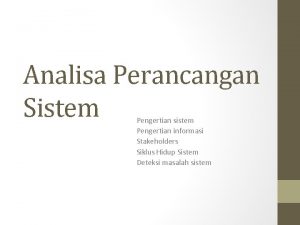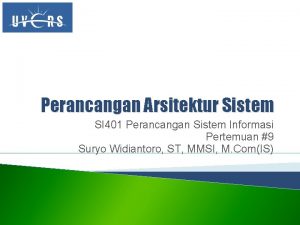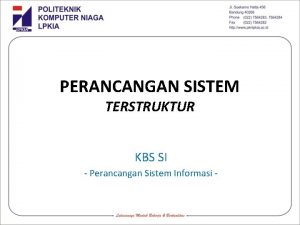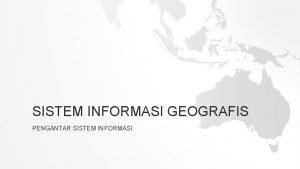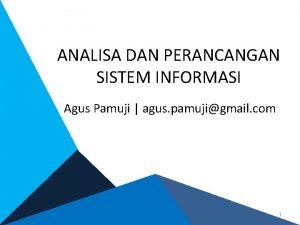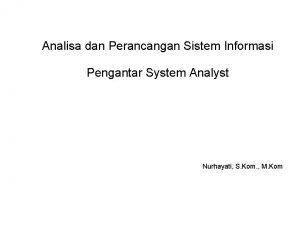MINGGU Ke 13 Analisa dan Perancangan Sistem Informasi

















- Slides: 17

MINGGU Ke 13 Analisa dan Perancangan Sistem Informasi Pokok Bahasan: Maintaining Information Systems Tujuan Instruksional khusus: Explain and contrast four types of maintenance Describe several factors that influence the cost of maintaining an information system Referensi: (1) Hoffer, J. A. , Joey F. George, dan Joseph S. Valacich (2005), Modern Systems Analysis and Design, Edisi ke-4, Prentice Hall. (2) Kendall, Kenneth. E. dan Julie E. Kendall (2005), Systems Analysis and Design, Edisi ke-6, Prentice Hall.

Learning Objectives ü Explain and contrast four types of maintenance ü Describe several factors that influence the cost of maintaining an information system ü Describe maintenance management issues including alternative organizational structures, quality measurement, processes for handling change requests and configuration management ü Explain the role of CASE when maintaining information systems 18. 2 Mata Kuliah. . . . Minggu …… Page 2

The Process of Maintaining Information Systems • Process of returning to the beginning of the SDLC and repeating development steps focusing on system change until the change is implemented • Four major activities – Obtaining maintenance requests – Transforming requests into changes – Designing changes – Implementing changes 18. 3 Mata Kuliah. . . . Minggu …… Page 3

The Process of Maintaining Information Systems • Deliverables and Outcomes – Development of a new version of the software and new versions of all design documents created or modified during the maintenance effort 18. 4 Mata Kuliah. . . . Minggu …… Page 4

Conducting System Maintenance 1. Corrective maintenance Changes made to a system to repair flaws in its design, coding, or implementation 2. Adaptive maintenance Changes made to a system to evolve its functionality to changing business needs or technologies 3. Perfective maintenance Changes made to a system to add new features or to improve performance 4. Preventive maintenance Changes made to a system to avoid possible future problems 18. 5 Mata Kuliah. . . . Minggu …… Page 5

Conducting System Maintenance The Cost of Maintenance 1. Many organizations allocate eighty percent of information systems budget to maintenance 2. Factors that influence system maintainability – – – 18. 6 Latent defects Number of customers for a given system Quality of system documentation Maintenance personnel Tools Well-structured programs Mata Kuliah. . . . Minggu …… Page 6

Conducting System Maintenance Managing Maintenance 1. Number of people working in maintenance has surpassed number working in development 2. Three possible organizational structures – Separate • Maintenance group consists of different personnel than development group – Combined • Developers also maintain systems – Functional • Maintenance personnel work within the functional business unit – Table 18 -4 presents the advantages and disadvantages to each approach 18. 7 Mata Kuliah. . . . Minggu …… Page 7

Conducting System Maintenance Managing Maintenance 3. Assignment of personnel – Maintenance work is often viewed negatively by IS personnel – Organizations have historically have rewarded people involved in new development better than maintenance personnel – Organizations often rotate personnel in and out of maintenance roles in order to lessen negative feelings about maintenance 18. 8 Mata Kuliah. . . . Minggu …… Page 8

Conducting System Maintenance Measures of Effectiveness 1. 2. 3. 4. Number of failures Time between each failure Type of failure Mean time between failures (MTBF) – A measurement of error occurrences that can be tracked over time to indicate the quality of a system 18. 9 Mata Kuliah. . . . Minggu …… Page 9

Controlling Maintenance Requests • Determine type of request – Error – Adaptation – Enhancement • 18. 10 Figure 18 -9 shows a flowchart for a request procedure Mata Kuliah. . . . Minggu …… Page 10

Figure 18 -9 Flowchart of how to control maintenance requests (Adapted from Pressman, 1992) 18. 11 Mata Kuliah. . . . Minggu …… Page 11

Configuration Management • • The process of assuring that only authorized changes are made to the system Baseline modules – • System librarian – • A person responsible for controlling the checking out and checking in of baseline modules when a system is being developed or maintained Build routines – 18. 12 Software modules that have been tested, documented, and approved to be included in the most recently created version of a system Guidelines that list the instructions to construct an executable system from the baseline source code Mata Kuliah. . . . Minggu …… Page 12

Role of CASE and Automated Development Tools in Maintenance • Traditional systems development • Development with CASE – Emphasis on coding and testing – Changes are implemented by coding and testing first – Documentation is done after maintenance is performed – Keeping documentation current is often neglected due to time-consuming nature of task 18. 13 Mata Kuliah. . . . – Emphasis is on design documents – Changes are implemented in design documents. – Code is regenerated using code generators – Documentation is updated during maintenance Minggu …… Page 13

Website Maintenance • Special considerations – 24 X 7 X 365 • Nature of continuous availability makes maintenance challenging • Pages under maintenance can be locked • Date and time stamps – Check for broken links – HTML Validation • Pages should be processed by a code validation routine before publication 18. 14 Mata Kuliah. . . . Minggu …… Page 14

Website Maintenance • Special considerations (continued) – Re-registration • When content significantly changes, site may need to be re-registered with search engines – Future Editions • Consistency is important to users • Post indications of future changes to the site • Batch changes 18. 15 Mata Kuliah. . . . Minggu …… Page 15

Summary • Maintenance – – Corrective Adaptive Perfective Preventive • Cost of maintenance • Managing Maintenance • Measuring effectiveness of maintenance 18. 16 Mata Kuliah. . . . Minggu …… Page 16

Summary • Controlling maintenance requests • Configuration management • Role of CASE and Automated Development Tools in Maintenance • Website Maintenance 18. 17 Mata Kuliah. . . . Minggu …… Page 17
 Usb input output
Usb input output Materi perancangan sistem informasi
Materi perancangan sistem informasi Analisis flowchart
Analisis flowchart Gambaran sistem informasi
Gambaran sistem informasi Sumber daya informasi adalah
Sumber daya informasi adalah Definisi analisa sistem
Definisi analisa sistem Judul dan nama anggota kelompok informasi gambar informasi
Judul dan nama anggota kelompok informasi gambar informasi Judul dan nama anggota kelompok informasi gambar informasi
Judul dan nama anggota kelompok informasi gambar informasi Sistem pakar dalam sistem informasi manajemen
Sistem pakar dalam sistem informasi manajemen Contoh laporan analisa dan evaluasi
Contoh laporan analisa dan evaluasi Sumber dan penggunaan kas
Sumber dan penggunaan kas Rs flip flop dapat dibuat dari kombinasi gerbang
Rs flip flop dapat dibuat dari kombinasi gerbang Analisa dan desain rangkaian sekuensial
Analisa dan desain rangkaian sekuensial Perancangan sistem terinci adalah
Perancangan sistem terinci adalah Perancangan sistem manajemen kinerja
Perancangan sistem manajemen kinerja Perancangan sistem terinci
Perancangan sistem terinci Gaji pt mei
Gaji pt mei Tahap perancangan sistem
Tahap perancangan sistem
